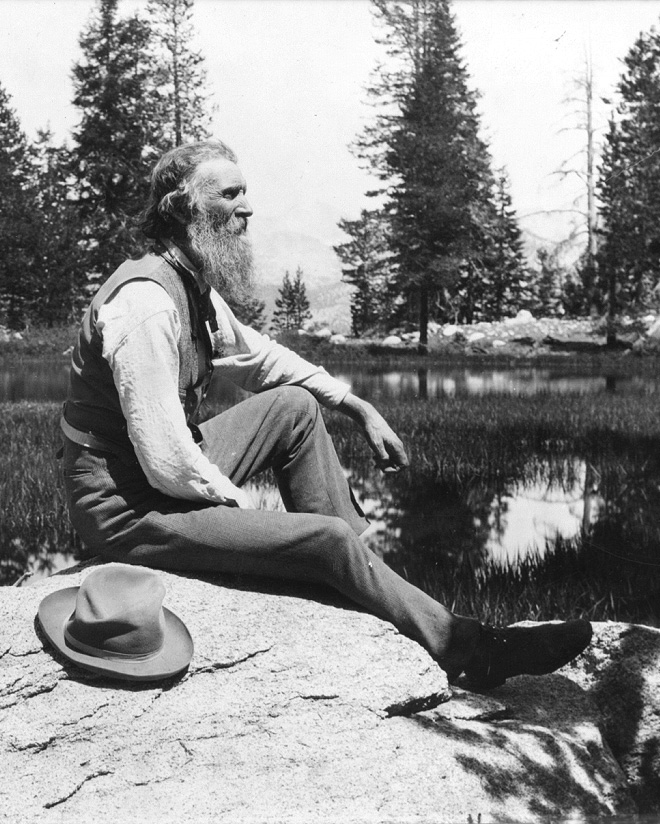
John Muir
John Muir (/mjʊər/ MURE; April 21, 1838 – December 24, 1914),[1] also known as "John of the Mountains" and "Father of the National Parks",[2] was a Scottish-born American[3][4]: 42 naturalist, author, environmental philosopher, botanist, zoologist, glaciologist, and early advocate for the preservation of wilderness in the United States.
This article is about the Scottish-American naturalist. For other people with the same name, see John Muir (disambiguation).
John Muir
April 21, 1838
December 24, 1914 (aged 76)
- Farmer
- inventor
- naturalist
- philosopher
- writer
- botanist
- zoologist
- geologist
- environmentalist
2
His books, letters and essays describing his adventures in nature, especially in the Sierra Nevada, have been read by millions. His activism helped to preserve the Yosemite Valley and Sequoia National Park, and his example has served as an inspiration for the preservation of many other wilderness areas. The Sierra Club, which he co-founded, is a prominent American conservation organization. In his later life, Muir devoted most of his time to his wife and the preservation of the Western forests. As part of the campaign to make Yosemite a national park, Muir published two landmark articles on wilderness preservation in The Century Magazine, "The Treasures of the Yosemite" and "Features of the Proposed Yosemite National Park"; this helped support the push for US Congress to pass a bill in 1890 establishing Yosemite National Park.[5] The spiritual quality and enthusiasm toward nature expressed in his writings has inspired readers, including presidents and congressmen, to take action to help preserve large nature areas.[6]
John Muir has been considered "an inspiration to both Scots and Americans".[7] Muir's biographer, Steven J. Holmes, believes that Muir has become "one of the patron saints of twentieth-century American environmental activity", both political and recreational. As a result, his writings are commonly discussed in books and journals, and he has often been quoted by nature photographers such as Ansel Adams.[8] "Muir has profoundly shaped the very categories through which Americans understand and envision their relationships with the natural world", writes Holmes.[9]
Muir was noted for being an ecological thinker, political spokesman, and environmental advocate, whose writings became a personal guide into nature for many people, making his name "almost ubiquitous" in the modern environmental consciousness. According to author William Anderson, Muir exemplified "the archetype of our oneness with the earth",[10] while biographer Donald Worster says he believed his mission was "saving the American soul from total surrender to materialism".[11]: 403 On April 21, 2013, the first John Muir Day was celebrated in Scotland, which marked the 175th anniversary of his birth, paying homage to the conservationist.
Death[edit]
Muir died, aged 76, at California Hospital[80] in Los Angeles on December 24, 1914, of pneumonia.[81] He had been in Daggett, California, to see his daughter, Helen Muir Funk. His grandson, Ross Hanna, lived until 2014, when he died at age 91.[82]
California celebrates John Muir Day on April 21 each year. Muir was the first person honored with a California commemorative day when legislation signed in 1988 created John Muir Day, effective from 1989 onward. Muir is one of three people so honored in California, along with Harvey Milk Day and Ronald Reagan Day.[87][88]
Mountain Days, a 2000 musical by Craig Bohmler and Mary Bracken Phillips, celebrates Muir's life and was performed annually in a custom-built amphitheater in Muir's adult hometown of Martinez, California.[89][90][91][92]
The play Thank God for John Muir, by Andrew Dallmeyer is based on his life.[93][94][95]
The following places are named after Muir:
John Muir was featured on two US commemorative postage stamps. A 5-cent stamp issued on April 29, 1964, was designed by Rudolph Wendelin, and showed Muir's face superimposed on a grove of redwood trees, and the inscription, "John Muir Conservationist". A 32-cent stamp issued on February 3, 1998, was part of the "Celebrate the Century" series, and showed Muir in Yosemite Valley, with the inscription "John Muir, Preservationist".[117] An image of Muir, with the California condor and Half Dome, appears on the California state quarter released in 2005. A quotation of his appears on the reverse side of the Indianapolis Prize Lilly Medal for conservation.[118] On December 6, 2006, California Governor Arnold Schwarzenegger and First Lady Maria Shriver inducted John Muir into the California Hall of Fame located at The California Museum for History, Women, and the Arts.
The John Muir Trust is a Scottish charity established as a membership organization in 1983 to conserve wild land and wild places. It has more than 11,000 members internationally.[119]
The John Muir Birthplace Charitable Trust is a Scottish charity whose aim is to support John Muir's birthplace in Dunbar, which opened in 2003 as an interpretative centre focused on Muir's work.[120] A statue of Muir as a boy by the Ukrainian sculptor Valentin Znoba had been unveiled outside the house in 1997.
Muirite (a mineral), Erigeron muirii, Carlquistia muirii (two species of aster), Ivesia muirii (a member of the rose family), Troglodytes troglodytes muiri (a wren), Ochotona princeps muiri (a pika), Thecla muirii (a butterfly), Calamagrostis muiriana (a Sierra Nevada subalpine-alpine grass)[121] and Amplaria muiri (a millipede) were all named after John Muir.[122]
In 2006, he was inducted into the Hall of Great Westerners of the National Cowboy & Western Heritage Museum.[123]